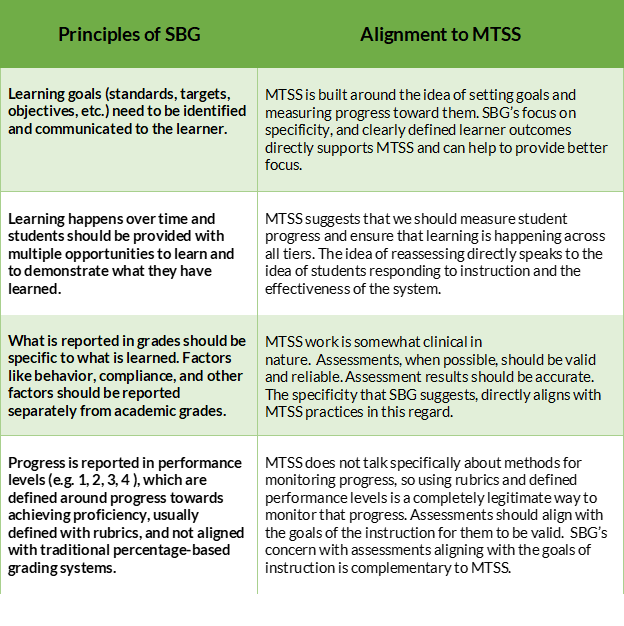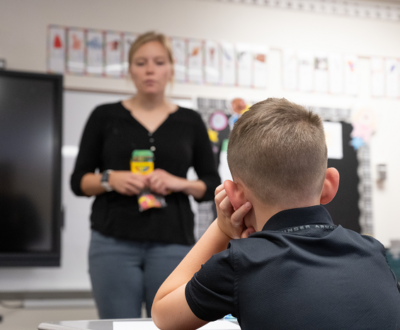These two and a half years of learning through the pandemic have impacted student learning. They have also revealed many of the inequities that underlie our educational system. Among our clients, we have noticed a strengthened commitment to multi-tiered systems of support (MTSS) to ensure that all learners access a quality education. Additionally, we have noticed a heightened interest in strengthening equitable, standards-based grading practices.
In this article, we address how to use standards-referenced assessments to strengthen MTSS. These initiatives can work simultaneously in your district to improve learning outcomes for all learners, while improving focus on meaningful measures of student learning.
Background and Context
Standards-based grading (SBG) is a system for teaching, learning, and communication. It guides teachers to focus assessment and grading practices on the specific academic goals of their instructional programs. Some general principles of SBG include:
- Teachers and students need to be aware of learning goals.
- Students should be provided with multiple opportunities to learn and to demonstrate what they have learned.
- Grades should reflect a student’s progress toward learning goals, including when s/he achieves mastery.
- Report behavior, compliance, and other factors separately from academic grades.
MTSS is a paradigm for schools to ensure that their system helps every student to be successful. The idea of “tiers” suggests that individual students need different levels of support at different times in their schooling. These tiers should be flexible, dynamic, and ready to meet students where they are, addressing their specific needs. Generally people consider three tiers:
- Tier 1 (Universal) being the most general, universal instructional environment that all students should have access to.
- In Tier 2 (Targeted), there is more specific, targeted instruction. Students may occasionally need this targeted instruction to be successful in the universal instructional environment.
- Lastly, in Tier 3 (Intensive), there is intensive instruction and progress monitoring that is highly targeted and time intensive. This usually involves some sort of programmatic shifts for the student.
The Intersection of SBG and MTSS
The first work of a well functioning MTSS system is to ensure that universal, Tier 1 instruction is high-quality and effective. Standards-based learning principles also support quality classroom instruction. These principles direct instruction and measures of its impact to focus on specific learning targets.
Example:
Teacher X has just given a standards-aligned unit test. After school, she refers to the answer key for the test, marks the answers right or wrong, counts the total points, and puts a percent correct at the top of the page. She records the total point value in a gradebook. The teacher sends home the tests with students the next day.
Teacher Y has just given the same unit test. After school, she reads through the students’ responses. When there is an error she pauses to think about why and writes quick notes for the student, mostly questions to prompt their thinking. She collects data about the performance of the students relative to each of the assessment’s learning targets in a gradebook, along with her own observations that she wants to remember. The teacher sends home the tests with feedback the next day.
Both teachers used a standards-aligned assessment, but their assessment practices are fundamentally different. In the first example, the teacher is not measuring or providing feedback on discrete learning targets: results for individual tasks aligned to different targets were aggregated into an overall score. In the second, standards-based grading example, grades for each of the learning targets were collected and feedback related to specific areas for improvement was shared with students.
SBG defines how students’ learning progression should be evaluated and measured, and what evidence should be collected. When school and district leadership are intentional about their SBG implementation, these same assessment results can work in harmony to improve and reinforce MTSS systems. Just think, how could the information collected in the second example inform any Tier 2 work? How do the starting places for Targeted (Tier 2) efforts look differently in examples one and two?
Aligning SBG and MTSS
The focus that SBG puts on the outcomes that align with standards and other defined learning targets directly aligns with and supports MTSS practices.
The reporting that is necessary for SBG can be used directly for MTSS. When districts are careful to implement assessment systems that align with the ideas of standards-based grading, the two systems can work in harmony. Alignment is critical. When assessment systems are adopted for the sake of MTSS without considering whether those assessments complement their standards-based grading systems, inefficiencies and redundancies result.
Improving Equity through Grading and MTSS
The language, ideas and philosophy of SBG can add meaning, focus, and efficiency to an MTSS system. All learners should have the supports they need throughout their learning progression. Assessment practices that provide classroom teachers and interventionists with meaningful information can improve both progress monitoring and help to describe student learning precisely and accurately. By using those same assessment tools through Tier 1 instruction, your schools improve with a renewed focus on learning and growth that seeks to help all students succeed.
Continue the Learning
The National Center on Intensive Intervention has great tools and resources to strengthen standards-relevant instruction and MTSS for both math and ELA linked here. Explore their examples of how to apply standards-relevant instruction across learning tier across literary and mathematics topics.
About Forefront
Forefront, by Forefront Education, helps schools collect, organize, and analyze assessment results to improve instruction, collaboration, and standards-based grading. Forefront improves communication between classroom teachers and interventionists. Our solution helps teachers collect and analyze assessment results. It provides detailed insights into student learning across learning tiers and illuminates Tier 1 trends. Explore our solution through an interactive demo or connect with our school partnerships team today for a guided tour.
About us and this blog
Our team and tools help schools implement standards-based grading, streamline assessment systems, and use meaningful data to drive decision-making.
Interested in Learning More?
Download our free Educator's Guide to Standards-Based Grading to access a roadmap to improve standards-based grading systems in your schools.
More from our blog
See all postsForefront is the only assessment data solution optimized for classroom assessment results, leveraging these results to fuel instruction, PLCs, and grading. Elevate meaningful assessment data district-wide to transform how you understand and communicate about student learning across your schools.
Copyright © 2025 Forefront Education, Inc. All Rights Reserved.









